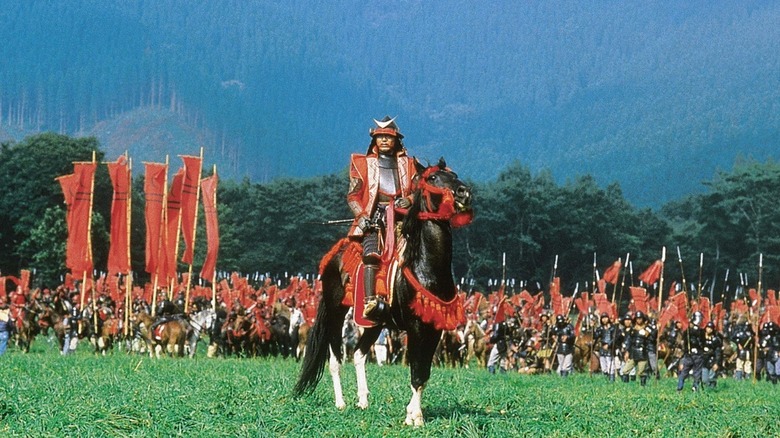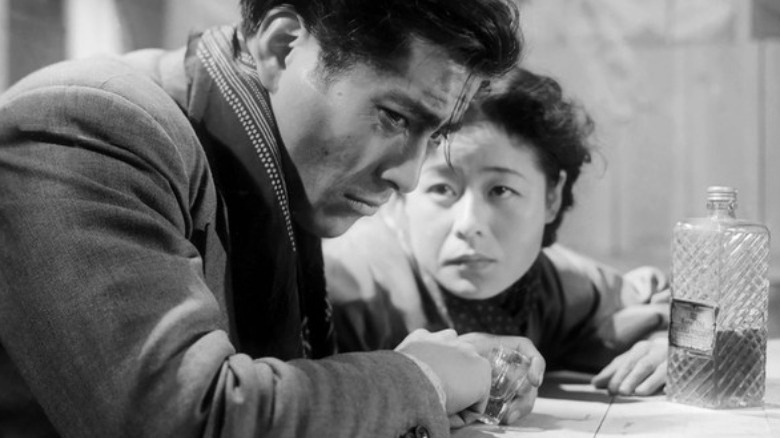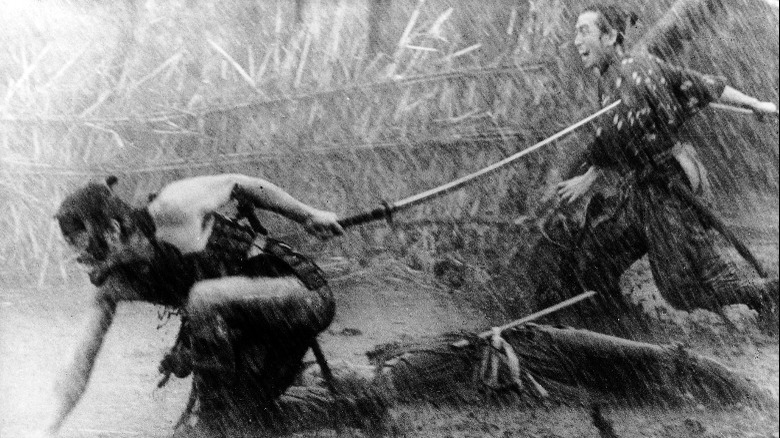Akira Kurosawa Never Wanted His Films To Go Exactly According To Plan
Japanese filmmaker Akira Kurosawa's contribution to cinema has been unprecedented. Throughout his long and eventful career, Kurosawa crafted films that were both historical and contemporary, which were simultaneously infused with grounded human drama and dreamlike qualities. As someone who was intimately involved in the filming process, Kurosawa paid extensive attention to the visual language of the stories he brought to life. This dedication to details is reflected in almost every film he made, from the profound, violent "Throne of Blood" to the surreal, episodic "Dreams."
However, while Kurosawa was meticulously dedicated to his cinematic vision, he made sure that his characters were given the chance to bloom organically. In an interview with John Powers titled "An Audience with the Emperor," Kurosawa explained how he never wanted any of his films to turn out exactly the way he had written or envisioned them. In order to clarify his stance, Kurosawa used the examples of "Ran" and "Kagemusha" — two films that began as ideas that were initially turned into paintings by Kurosawa himself. The end results were markedly different. "Kagemusha" ended up being more complex and darker as a medieval drama set in the Sengoku era, while "Ran" became equal parts intensely autobiographical and a reinterpretation of William Shakespeare's "King Lear."
But, what exactly does Kurosawa mean when he says that he prefers his films to turn out differently than he intended? Let us dive deep into it.
Kurosawa's characters assume a life of their own
As Kurosawa had a reputation for being involved with every aspect of the filmmaking process, the director would often make his own storyboards with the help of paintings. In the late 1970s, during the time he conceived the core ideas for the epic samurai drama, "Kagemusha," Kurosawa created a unique body of work that would serve as the foundation for the film. He did the same for his 1985 film "Ran," whose visuals evoke the dreamlike quality of his brushstrokes that created lush meadows and cloudy skies.
In his interview with Powers, Kurosawa stated that it was "very, very important" to him that his artistic vision developed organically throughout the filming process, which included actors contributing to their own interpretations of the characters. He said:
"In the case of Ran and Kagemusha, I did paintings that elaborated the visual concept before the actual filming began. But it's very, very important to me not to film the movie exactly the way it's written or exactly the way I have it worked out ahead of time...Because you're dealing with actors and circumstances of nature, a lot of things can change, and it's important to be able to take advantage of those things at the moment they occur. That's what makes me happy about filmmaking: to get something different and better than what I conceived at the earlier stage."
Kurosawa went on to say that a lot of directors have a strict idea of what or who their characters should be, which leads to them treating the actors "like puppets." Opposed to such a didactic way of filmmaking, Kurosawa stresses the importance of allowing characters to develop on their own, which can only happen if artistic freedom is preserved.
Unpredictable, beautiful results
In "Akira Kurosawa: Something Like an Autobiography," which details his approach to creating art, Kurosawa talks about the "unpredictability" that becomes a natural factor while filming certain sequences. Although continuity, along with the basic beats of a story, is already mapped out, shots can end up capturing a completely fresh layer or theme, producing "a startling effect." While Kurosawa and his steadfast team of collaborators made sure that these changes did not explicitly upset the true intent behind the film, such wild-card occurrences were allowed to play out to interesting ends. The filmmaker says:
"This process is similar to that of a pot being fired in a kiln. Ashes and other particles can fall onto the melted glaze during the firing and cause unpredictable but beautiful results. Similarly, unplanned but interesting effects arise in the course of directing a movie, so I call them 'kiln changes.'"
An example of such "kiln changes" occurred during the filming of "Seven Samurai," wherein it was impossible to predict how the bandits at the beginning of the film would attack the village during a heavy downpour. To preserve spontaneity, Kurosawa used three cameras to film the sequence simultaneously, which lends to the anxiety that surrounds the eve of the bandit attack.
As a result, expectations of how such an action-filled scene would unfold were subverted, leading to a strong opening that perfectly captures the themes of cyclical violence and human suffering that the film champions. As explained by Kurosawa, the results achieved here were unprecedented yet effective, which would not have been possible if he had taken a by-the-book approach with his actors and directing as a whole.


